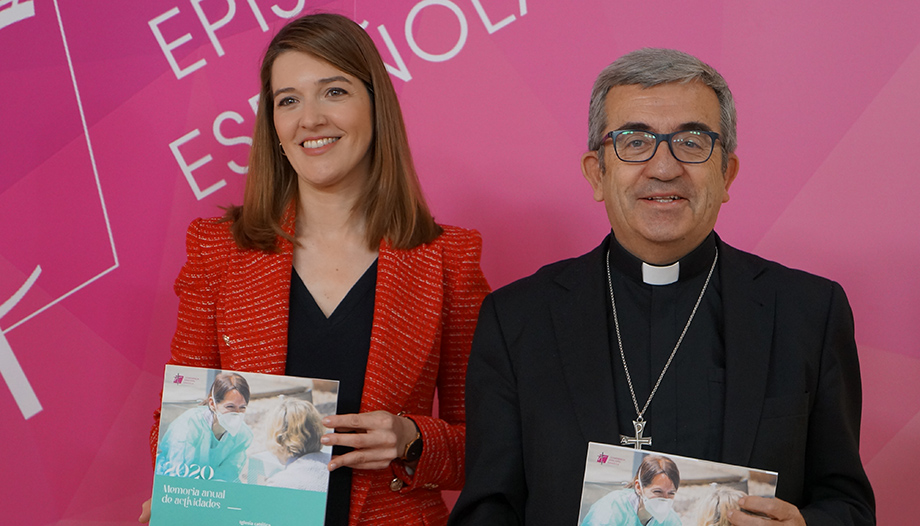 "The Church has an answer for the real problems that are on the street."
"The Church has an answer for the real problems that are on the street." The Church invites to mark the X in the Renta as a "social shield" of aid
The Church invites to mark the X in the Renta as a "social shield" of aid2020 is marked in the world's mental agenda as the year in which the pandemic began and which, until its end, was characterized by restrictions on movement, overcrowding and increased requests for financial and welfare assistance.
In fact, both Monsignor Luis Argüello, secretary of the Spanish Episcopal Conference, and the director of the Transparency office, Ester Martín, have described the 2020 exercise in the Church as a "difficult year" during the presentation of the report on the activities of the Catholic Church in Spain for the year 2020.
Argüello, "we have lived through the experience of closed churches, but also in which people, because of the pandemic, have approached the Church for help, consolation and hope to be able to move forward. The report on the activities of the Church is a moment "to give thanks and to be accountable", stressed the spokesman of the EEC.
Less money, more needs
A year in which the activity of the Church, according to this report which summarizes, briefly, the data presented by the Church to the Ministry of the Presidency, has seen an exponential increase in the need for assistance.
In this regard, Ester Martín highlighted the nearly 700 actions that were launched in the COVID context by different Church institutions, in addition to those already being carried out before the socio-health emergency. Of these, more than half, 359, have been welfare actions, 175 pastoral, 89 health and 57 related to education and training initiatives.
Also surprising was the figure of 4,030,871 people who were accompanied and cared for in one of the Church's 9,222 centers. Among these centers are centers for alleviating poverty, centers for assisting immigrants, centers for women who are victims of violence or minors, as well as homes for the elderly, the chronically ill and the disabled, and hospitals. More than half of these 4 million people attended centers of the first type, while just over one million attended centers of the second type.
What the Spanish Church saves the State
One fact to keep in mind: through all the assistance activities carried out in different areas, the Church generates an economic value for society of 589,629,655€.
To this must be added the 3,895 million euros that the Church saves the State in the field of education and training. Not in vain, in Spain there are 2,558 centers of Catholic initiative, of which 2,419 are subsidized. More than one and a half million students attend these centers in which 133,770 people work. Among these centers, the Church supports 423 special education centers that attend 40,118 students.

In spite of the pandemic, the drop in income, etc., the Church, as Bishop Argüello wanted to emphasize, "has continued to be at the side of those who asked for help. An effort that has been possible thanks to the thousands of people: lay people, consecrated and priests, who dedicate their lives and time to these activities. Martín wanted to highlight them because "they are still such an unknown face of the Church. That is why this Report makes many people see themselves reflected". Also unknown are those 16,500 priests who have given 29 million hours through their pastoral work in the 23,000 Spanish parishes.
Less sacramental presence but more online
The closure of churches in many Spanish communities led to an evident decrease in sacramental activity, which is reflected in this report. Even so, in 2020, 100,222 baptisms took place, 161,950 people received first communion, 79,447 young people or children received the sacrament of confirmation, 12,679 couples married and 29,627 people received the anointing of the sick.
Argüello pointed out that "the closing of churches coincided with months in which Holy Week and the "high season" of communions, weddings and confirmations are celebrated, for example. In addition to the closure, the opening was made with limited capacity and with the legitimate fear of many people to participate in joint celebrations. This does not detract from the decline that has already been observed and which is more related to the process of secularization of our country". Ester Martin also added that, "despite the fact that people did not go to the temples, there were millions who participated in celebrations through, for example, television".
Final income tax data
297,680,216 is the total amount allocated to the Catholic Church by taxpayers. This amount, although somewhat lower than the previous year, represents a decrease of only 2%, which is a recognition of the work of the Church.
Ester Martín also referred to the crisis that is evident in the economy of the Spanish dioceses, almost half of which have a deficit.
The drop in voluntary contributions from the faithful was 7%, a small decline considering the economic climate we are in.
Commitment to transparency
Once again this year, Ester Martín, PwC, has externally reviewed the report, which this year includes data on 392 indicators of all the Church's activity, resulting in some 150,000 records. In 2007, when the tax allocation model changed, only 77 indicators were reported, an increase of 500%.
In the area of transparency, other initiatives have been implemented, such as the development of an accounting plan for all diocesan entities, manuals of good management practices, transparency offices and transparency portals, which provide information at the diocesan level on their work and on all resources and their destination.











